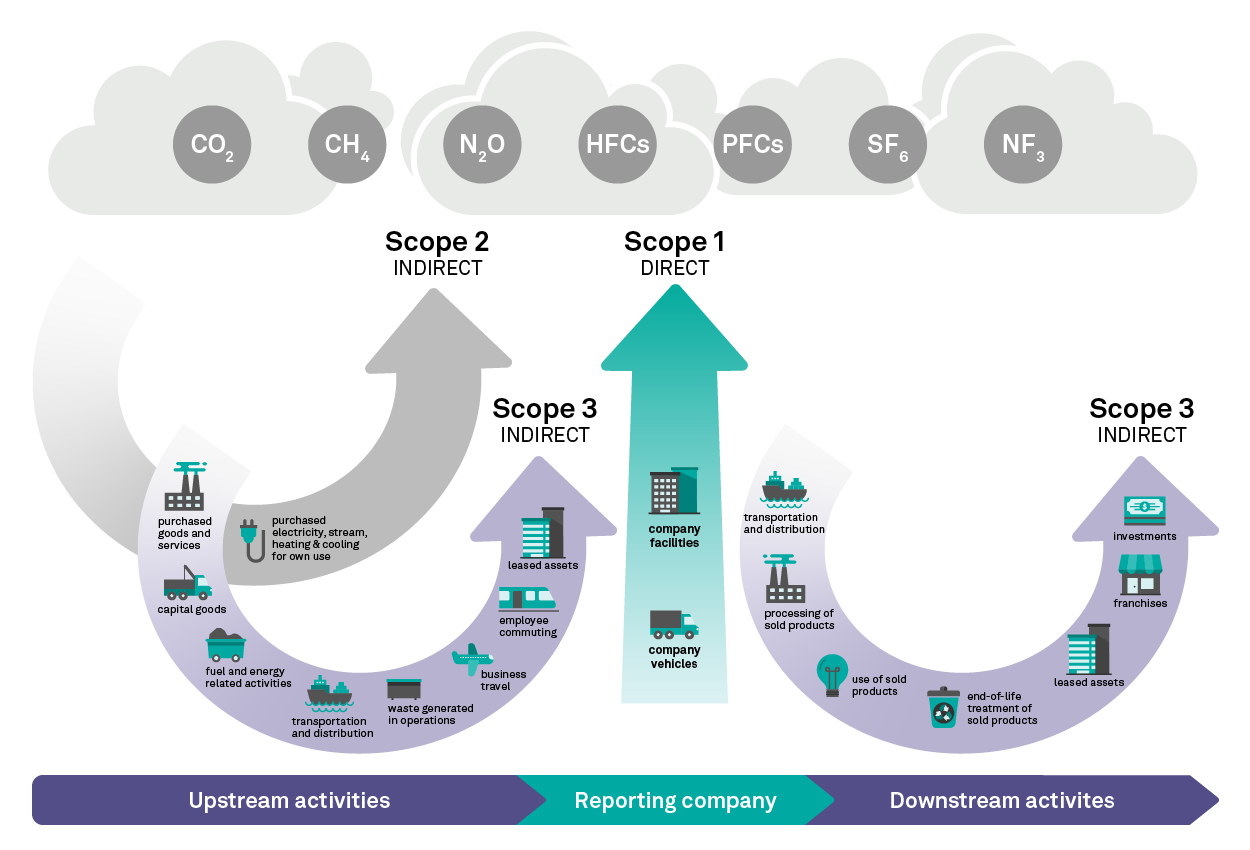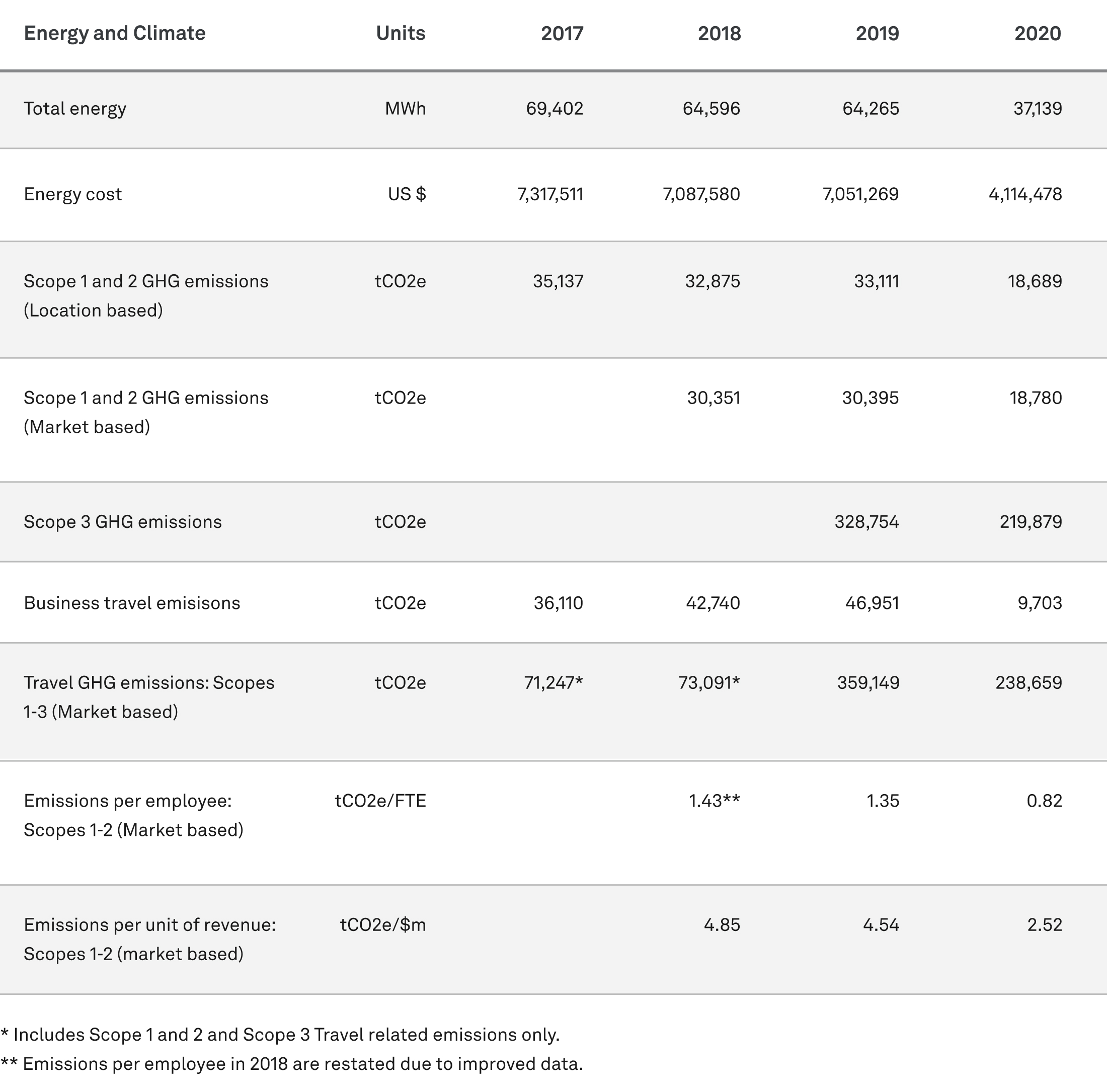The executive team at S&P Global recognized early on that, as a provider of environmental intelligence to companies and the capital markets, its organization must have its own best-in-class emissions reduction targets, strategies and disclosure.
The company has issued sustainability reports since 2011 and, in 2018, the Corporate Responsibility team was elevated to the office of the CEO. A year later, the company began publishing an annual disclosure of climate-related risks and opportunities. This adhered to the guidelines endorsed by the Financial Stability Board’s Task Force on Climate-related Financial Disclosures (TCFD).
In its 2020 TCFD report, S&P Global became one of the first companies to introduce a carbon-adjusted earnings per share metric into its financial reporting. The measure − calculated based on the theoretical cost per share of the tons of CO2 in each period subtracted from regular earnings per share − provides greater transparency into the cost of carbon emissions from company operations and integrates climate change considerations in the decision-making process.
S&P Global announced a net zero strategy and roadmap in February 2021, joining the world’s top tier of corporate climate leaders. The approach to reaching this goal involves reducing emissions wherever possible and replacing high-carbon energy sources with low-carbon alternatives. Offsets will be used sparingly to help bridge gaps in low-carbon solutions. The new targets were validated by the Science Based Targets Initiative (SBTi), and are consistent with reductions required to keep warming to 1.5°C. Of the nearly 1,400 companies taking action, just one quarter have set targets at this level.
Three Net Zero Goals
Using 2019 as a baseline year, the company’s science-based targets commit the organization to three main goals:
- 25% reduction in absolute Scope 11 and 22 greenhouse gas (GHG) emissions from global operations by 2025.
- 25% reduction in absolute Scope 33 GHG emissions from employee business travel by 2025.
- 81% of the company’s top suppliers (by emissions) have set their own science-based targets by 2025.
Figure 1: What’s the difference between Scope 1, 2 and 3 emissions?

The company expects to reach net zero by 2040. This is 10 years earlier than the timeline suggested by the Special Report on Global Warming of 1.5ºC published by the Intergovernmental Panel on Climate Change (IPCC), but is viewed as being a balance between an aggressive target and one that sets a reasonable pace to adjust the business in a way that is both thoughtful and achievable. This was approved by the Board of Directors, a group that is highly involved in the sustainability strategy, seeing it as both an opportunity to promote growth and reduce risk.
Leveraging S&P Global ESG Services
S&P Global recently announced the launch of its new ESG and sustainability organization: S&P Global Sustainable1. This centralized group represents S&P Global's integrated sustainability offerings and is comprised of a dedicated team that provides comprehensive views on sustainability, including key ESG and climate topics. Sustainable1 brings together S&P Global's resources and full product suite of benchmarking, analytics, evaluations and indices that provide customers with a 360-degree view to help achieve their sustainability goals.
Scope 1 and 2 emissions are internal, so S&P Global works with its real estate partner to gather details on energy expenditures, which are then provided to Sustainable1 to calculate quarterly carbon emissions. For Scope 3, the procurement team provides data on the company’s spend, which Sustainable1 analyzes by industry and activity to calculate emissions. Progress on the net zero targets are analyzed quarterly and tied to short-term bonuses for the office of the CEO and corporate employees within service areas that are shared across the organization, such as finance, legal and compliance. Timely data is essential to monitor movements for this purpose, as well as for external reporting.
S&P Global is also a user of its own Corporate Sustainability Assessment (CSA), an annual survey-based evaluation of companies’ sustainability practices first established in 1999, which generates company-level ESG scores. The CSA provides detailed ESG benchmarking insights for participants to better integrate sustainability and business strategy. The scores are closely monitored as the company strives for continual improvement.
Progress is Being Made
S&P Global has a small carbon footprint given the nature of the business, and most of the emissions come from purchases of capital goods and business travel. Both impact areas are handled through the corporate procurement team, which has taken steps to establish useful tracking tools and undertake research and analysis to help the organization make smarter decisions. Engagement with Tier 1 suppliers is an essential step in advancing the net zero strategy. This has included one-on-one discussions, joint surveys and tracking a supplier’s own emission strategy. There has also been extensive employee education regarding what to buy and from whom, plus new policies in both business travel and vendor selection.
The organization has identified carbon-reduction opportunities to meet the 2025 targets, including office site consolidations and operational changes in areas such as heating, air conditioning and lighting. It is also exploring renewable energy solutions and, as of April 2021, three offices had switched to 100% renewable energy tariffs, with potential annual savings of 2,634 tCO2e based on 2019 figures. As can be seen in Figure 2 below, much has been accomplished in the last several years. Climate, energy and broader environmental data cover 96 offices across 35 countries. Site-based environmental management systems are used to identify impacts, establish targets and collect, monitor and report data.
Figure 2: Annual performance data on energy consumption and operational emissions

Still Early Days
We just released our net zero strategy in February 2021, so it is still relatively new for us. One of our biggest challenges at this point is being comfortable with the unknown. We have the next five years mapped out well, but, like many other companies, we need to take a leap of faith at this stage about how we will meet our ultimate 2040 goal. So much is still unknown about technology developments and related issues, but science-based targets have put us on a good path. We will continue to reevaluate as we move forward and go to the next phase.
S&P Global also realized early on that a net zero strategy will only be successful if there is a cultural change across the organization about how decisions are made. By 2040, many employees may have retired, so this needs to be a broad-based initiative, not just tied to a number of specific functions. We have stated a public goal on business travel by 2025 but we want to see clients and be at conferences, so we need to rethink what that looks like. We believe it comes down to empowering employees to make the right decisions, so we need to provide them with supporting tools and information. For example, if they know they will generate 90% fewer emissions if they go to a meeting by train versus plane, they have the facts to choose the best option.
Sharing the Story
S&P Global spends a great deal of time internally on ESG education and what it means for employees in their specific jobs. The company also hears that this is an important area for potential new employees considering their career paths. Externally, there are regular investor meetings, and the ESG questions are becoming more sophisticated as the field matures.
The company is also using its expertise as a neutral data and analytics provider to share its point of view as new policies are being discussed. Doug Peterson, President and CEO, advises the G7 on climate disclosure and is involved in the Global Financial Alliance for Net Zero. Additional climate-related commitments, among others, includes involvement in UN Climate Change, the United Nations entity charged with advancing progress on climate action, and Business Ambition for 1.5ºC, a commitment to limit global temperature rise to 1.5º C above pre-industrial levels.
S&P Global 2020 Impact Report and the 2021 TCFD Report
1 Scope 1 – All Direct Emissions from the activities of an organization or under their control, including fuel combustion on site, such as gas boilers, fleet vehicles and air-conditioning leaks.
2 Scope 2 – Indirect Emissions from electricity purchased and used by the organization; emissions are created during the production of the energy and eventually used by the organization
3 Scope 3 – All Other Indirect Emissions from activities of the organization, occurring from sources that they do not own or control; these are usually the greatest share of the carbon footprint, covering emissions associated with business travel, procurement, waste and water.

